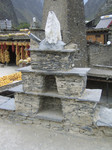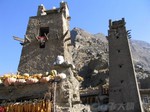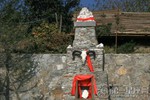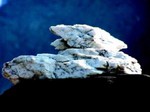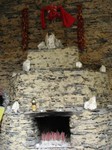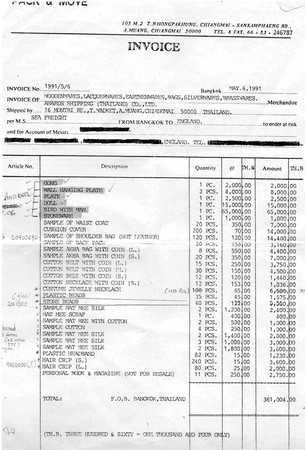
发出的证明书
这是真正的馆藏级邦提克珠,极其罕见和精美。无论是淘宝还是实体店,能见到如此级别邦提克珠的机会为零。这种馆藏级的珠子全部在一些收藏大家手中,根本没有机会在市场上流通
最美丽的珠
感觉的力量珠!
他们给你带来良好的财富!七界这里:可能北斗星7明亮的星星?
铀的痕迹,在二氧化硅。这将导致荧光。
如果你是一个资深的珠饰收藏家,如果你是一个罕见的珠收藏家?这些的,绝对满足您的特定需求
羌族的羊图腾崇拜
他们带给你身体健康!
更多照片可以要求每一个珠。
最古老的佛教图腾来自中国!八叶莲花象征!
虚假紫外线灯是不可能的,这是唯一的真正的考验的第一代邦提克珠
他们给你带来成功!
包括一些见过的最古老的代邦提克珠 !
包括非常罕见的10条纹虎珠!(52mm)
他们给你带来好运!
中国木化石 /
深圳市城市管理局,深圳仙湖植物园,国土资源部沈阳地质矿产研究所编著.
当你购买钻石。当你购买蓝宝石。当你购买一个红宝石。只有最有经验的,如果能真正通过考试用10倍放大镜告诉。接下来的程序是使用很多工具,包括显微镜检查宝石。我的所有珠子显微镜下检查。每个结果公布与显微镜下拍摄的照片。
谨防假货!
显微照片不能说假话!这些都是正品中国古代珠子!
Email: info@ccbeads.co.uk
Where to find us:
Business hours
Telephone
NEW 3! PROVENANCE: A STRANGE TWIST IN THE TALE
Please scroll down for original shipping invoice from 6th May 1991. Necklaces listed as 'Stone Beads'.
Twenty-five years ago in Northern Thailand I encountered a small ramshackle establishment, little more than an open space with a covering, where there was a family selling an assortment of wares, Finely embroidered bags, belts with old Burmese coins etc. What caught my eye were many strings of strange-looking beads, with dazzling patterns. I thought they were made from stone. Striking up a friendship with the family, I ascertained that they were from Burma. We conversed using my Thai language skills, which were far from perfect.
I bought many bags and belts from the family. They were very pleased with me purchasing such an amount, and helped me choose the 40 necklaces that I also purchased.
When I returned to visit the family again 5 months later, a new building was being erected on the site. I searched for them in vain. I did notice that the Night Bazaar was full of large amounts of brand new 'pumtek' style beads.
Today the collection is still intact, albeit with half the necklaces broken up due to string breakages etc.
THE QIANG OF TODAY STILL WORSHIP WHITE QUARTZ STONE. THE BEADS ARE MADE FROM WHITE QUARTZ-LIKE CRYSTALLIZED PETRIFIED WOOD. THEIR WORSHIP OF THE MATERIAL STRETCHES BACK THOUSANDS OF YEARS.
http://usa.chinadaily.com.cn/epaper/2016-06/09/content_25659613.htm
'Luo Jinyong, director of the Hanchuan Museum in Aba and a Qiang culture expert, says: "When compared with the government cultural protection project, the Dasi model is more sustainable and effective.
"The Qiang have the same ancestors as the Han, who later became the largest ethnic group in China.
"So, for most Han tourists, visiting an ancient Qiang village is like calling on their ancestral brothers, who have maintained some semblance of an ancient lifestyle."
The Qiang believe that everything in nature has a soul. They worship white quartz stones and place the snow-white stones on their houses to protect the family.
Luo says there are two explanations for the white-stone worship - one is that their ancestors made fire using it; and the other is that the ethnic group won a life-and-death struggle with it when the enemy mistook the white stone for snowballs.'
BELOW: MODERN DAY QIANG VILLAGES WITH WHITE QUARTZ WORSHIP.
WHY DO WE CLAIM OUR BEADS ARE SO ANCIENT?
The original so called first-generation beads (第一代邦提克珠) were made in China – probably by the ancient Qiang. Enemies of the Shang, they were taken prisoner and became experts at oracle bone production (Nicola Di Cosmo). NB we originally thought the beads originated in Burma and dismissed the statements from Chinese authors that the Qiang (ancestors of the Chin) brought the beads with them from China. Three years later, we now agree with them.
Reasons:
a) Many of the beads fluoresce green under SW light. This (from extensive research) indicates uranium traces in the silicon. There are vast amounts of uranium in China, whilst almost unheard of in Myanmar. This does not mean that beads which do not fluoresce are not originals. This is adequately depicted on our site using Triassic petrified wood examples. Made from very hard material, close-up views of holes show groove wear. Ancient drilling techniques, including hole-pecking.
b) Under the microscope, the beads appear to be made from the petrified Araucarioxylon species. The only ref we could find of this species in Myanmar was from the tertiary – 2-5 million years ago (Prakash, pdf on our site). Chinese Araucarioxylon, as per Arizona, dates back 225 million plus years. The beads comprise materials requiring a process taking at least 45 million years : Opal -A → opal -CT → quartz! ( Reference CL Stein ' silica recrystallization of petrified wood. ' 1982).
c) We believe that we have linked the bead designs to ancient Chinese cultures dating back to 6000 years. This includes Daxi, Machang, Majiayao and the Shang Dynasty. Designs have been found on pottery, bronze, jade and oracle bones.
d) This follows through to the Xingde Text B diagrams in the Mawangdui Silk Book.
e) The beads would have been extremely difficult to manufacture and inlay. The jade-like material containing uranium would have give off far more Qi than gold and most suitable for Feng Shui purposes. This is further explained on page one of our site.
f) We have noticed close similarities in Native American rock art and patterns on the beads. Symbol for medicine man identical with diamond eye beads. Hopi Indian links – Petrified Forest houses built of Araucarioxylon, identical pattern on a N A bead etc.
g)'.... Gin Za Tuang, nevertheless, maintains that the Chin ancestors were Ch’iang, but he
mentions nothing about the Ch’ing.
Gin Za Thang simply follows Than Tun’s and G. H. Luce’s theory of the origin of Tibeto-Burmans and other groups of humans, believed to be the ancestors of the Southeast Asian peoples. According to
Professors Than Tun and Gordon Luce, [8] the Ch’iang were not just the ancestors of the Chin but of the entire Tibeto-Burman group, and they ‘enjoyed a civilization as advanced as the Chinese, who
disturbed them so much that they moved south’ (Than Tun 1988: 3). Regarding this, Professor Gordon Luce says:
With the expansion of China, the Ch’iang had either the choice to be absorbed or to become nomads in the wilds. It was a hard choice, between liberty and civilization. Your ancestors chose liberty; and they must have gallantly maintained it. But the cost was heavy. It cost them 2000 years of progress. If the Ch’iang of 3000 BC were equals of the Chinese civilization, the Burmans [and the Chin] of 700 AD were not nearly as advanced as the Chinese in 1300 BC (Cited in Than Tun 1988: 4).'
Source: http://www.chro.ca/index.php/resources/articles/325-the-origin-of-the-chin
h) The Qiang of today inhabiting the Yunnan area of China worship white quartz stones. They place these on the roofs of their houses and around fireplaces. The importance of the white quartz is deeply embedded in Qiang history dating back many thousands of years. The stone must be white, black denoting evil. This material is very similar to the beads' white quartz- like composition.
Below: Copy of Original Invoice from 6th May 1991.
NB The 'Sample Akha Bag' etc is an error on the part of the shipper.We still have most of the bags and belts, the style identifies them as Haka Chin products. The shipper would not have been familiar with the Burmese Haka Chin goods.
I spent in excess of THB 30,000 which in 1991 was a great deal of money. Until I started researching the beads and Chin 3 and a half years ago, I did not realize that the Haka had retained their most precious heirlooms until they were so desperate that they had to let them go. Beads had first appeared in India in the early 80s and most of them were probably copies made in the 1920s. So many copies entered the chain from the 20s that the beads lost their value to the Chin.
The Haka necklaces are referred to as ' Stone Beads'.
Click to enlarge
ABOVE: EXAMPLES OF VEINS RUNNING THROUGH THE PETRIFIED WOOD, WHICH ILLUSTRATES WHY ALL BEADS DO NOT FLUORESCE, YET CAN BE MADE FROM THE SAME SOURCE OF PETRIFIED WOOD



















